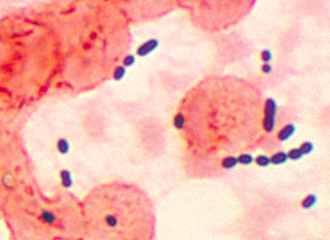Sputum culture

Sputum culture is a laboratory test performed to detect and identify bacteria or fungi that infect the lungs or breathing passages. It is commonly used to diagnose respiratory infections such as pneumonia, tuberculosis, and bronchitis.
Procedure[edit]
The test involves collecting a sample of sputum, which is the mucus and other matter brought up from the lungs by coughing. The sample is then placed in a medium that promotes the growth of microorganisms. This medium is observed over a period of time to see if any bacteria or fungi grow.
Collection[edit]
To collect a sputum sample, the patient is usually asked to cough deeply to bring up sputum from the lungs. In some cases, a saline solution may be inhaled to induce coughing. The sample is then collected in a sterile container and sent to the laboratory for analysis.
Incubation[edit]
In the laboratory, the sputum sample is spread on a culture medium and incubated at a specific temperature to encourage the growth of microorganisms. The incubation period can vary but typically lasts from 24 to 48 hours.
Identification[edit]
Once growth is observed, the microorganisms are identified using various biochemical tests, staining techniques, and sometimes molecular methods. The identification process helps determine the specific type of bacteria or fungi present in the sample.
Clinical Significance[edit]
A sputum culture is particularly useful in diagnosing bacterial pneumonia, tuberculosis, and other lower respiratory tract infections. It helps in identifying the causative agent and determining its antibiotic sensitivity, which is crucial for effective treatment.
Bacterial Pneumonia[edit]
In cases of bacterial pneumonia, a sputum culture can identify the specific bacteria responsible for the infection, such as Streptococcus pneumoniae or Haemophilus influenzae. This information is vital for selecting the appropriate antibiotic therapy.
Tuberculosis[edit]
For tuberculosis, a sputum culture is one of the primary diagnostic tools. The presence of Mycobacterium tuberculosis in the sputum confirms the diagnosis and helps in monitoring the effectiveness of treatment.
Fungal Infections[edit]
Sputum cultures can also detect fungal infections like aspergillosis and histoplasmosis. Identifying the specific fungus involved is essential for choosing the right antifungal medication.
Limitations[edit]
While sputum culture is a valuable diagnostic tool, it has some limitations. The test may not detect all types of bacteria or fungi, and contamination from the mouth or throat can sometimes interfere with the results. Additionally, some microorganisms may take longer to grow, delaying the diagnosis.
See Also[edit]
References[edit]
<references group="" responsive="1"></references>
Ad. Transform your life with W8MD's Budget GLP-1 injections from $75


W8MD offers a medical weight loss program to lose weight in Philadelphia. Our physician-supervised medical weight loss provides:
- Weight loss injections in NYC (generic and brand names):
- Zepbound / Mounjaro, Wegovy / Ozempic, Saxenda
- Most insurances accepted or discounted self-pay rates. We will obtain insurance prior authorizations if needed.
- Generic GLP1 weight loss injections from $75 for the starting dose.
- Also offer prescription weight loss medications including Phentermine, Qsymia, Diethylpropion, Contrave etc.
NYC weight loss doctor appointmentsNYC weight loss doctor appointments
Start your NYC weight loss journey today at our NYC medical weight loss and Philadelphia medical weight loss clinics.
- Call 718-946-5500 to lose weight in NYC or for medical weight loss in Philadelphia 215-676-2334.
- Tags:NYC medical weight loss, Philadelphia lose weight Zepbound NYC, Budget GLP1 weight loss injections, Wegovy Philadelphia, Wegovy NYC, Philadelphia medical weight loss, Brookly weight loss and Wegovy NYC
|
WikiMD's Wellness Encyclopedia |
| Let Food Be Thy Medicine Medicine Thy Food - Hippocrates |
Medical Disclaimer: WikiMD is not a substitute for professional medical advice. The information on WikiMD is provided as an information resource only, may be incorrect, outdated or misleading, and is not to be used or relied on for any diagnostic or treatment purposes. Please consult your health care provider before making any healthcare decisions or for guidance about a specific medical condition. WikiMD expressly disclaims responsibility, and shall have no liability, for any damages, loss, injury, or liability whatsoever suffered as a result of your reliance on the information contained in this site. By visiting this site you agree to the foregoing terms and conditions, which may from time to time be changed or supplemented by WikiMD. If you do not agree to the foregoing terms and conditions, you should not enter or use this site. See full disclaimer.
Credits:Most images are courtesy of Wikimedia commons, and templates, categories Wikipedia, licensed under CC BY SA or similar.
Translate this page: - East Asian
中文,
日本,
한국어,
South Asian
हिन्दी,
தமிழ்,
తెలుగు,
Urdu,
ಕನ್ನಡ,
Southeast Asian
Indonesian,
Vietnamese,
Thai,
မြန်မာဘာသာ,
বাংলা
European
español,
Deutsch,
français,
Greek,
português do Brasil,
polski,
română,
русский,
Nederlands,
norsk,
svenska,
suomi,
Italian
Middle Eastern & African
عربى,
Turkish,
Persian,
Hebrew,
Afrikaans,
isiZulu,
Kiswahili,
Other
Bulgarian,
Hungarian,
Czech,
Swedish,
മലയാളം,
मराठी,
ਪੰਜਾਬੀ,
ગુજરાતી,
Portuguese,
Ukrainian
